Few flowers “talk” to gardeners. A snapdragon will.
The name “snapdragon” derives from the flower’s resemblance to a dragon’s mouth, which opens and closes when you gently squeeze the sides.
Scientifically known as Antirrhinum majus, snapdragons originate from the rocky regions of Europe, North Africa, and the United States. The flower boasts a wide array of colors, including rare shades like green and bronze. Some varieties display bicolor combinations, adding to their appeal in gardens and floral arrangements.
Snapdragon flowers are edible (though bitter) and are sometimes used as garnishes in cuisine.
Fun fact: The ancient Greeks and Romans wore snapdragon garlands to protect them against witchcraft and evil spirits. Was it mere superstition? You can be the judge.
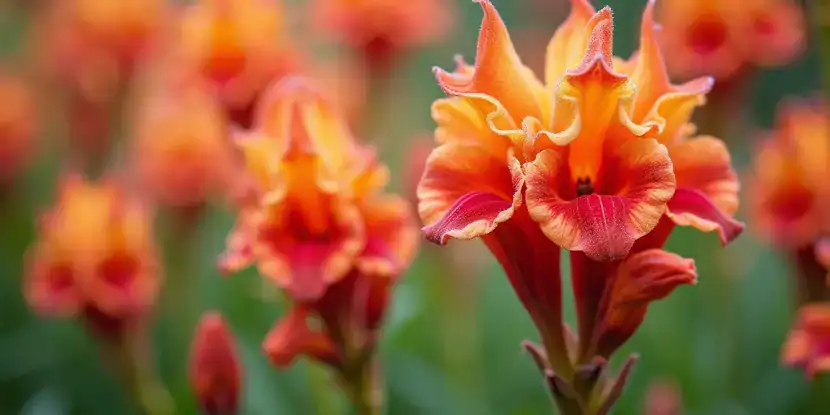
A striking red and orange snapdragon in the garden.
Why Snapdragons Belong in Your California Garden
Why plant snapdragons in SoCal? The versatile flower does far more than “talk.”
- Snapdragons thrive in cooler weather and can produce brilliant blossoms in fall and spring.
- The flowers attract bees, butterflies, and other pollinators, boosting the biodiversity of your garden.
- Their tall, upright stems make them striking focal points for flower beds and arrangements.
Snapdragon Varieties
Snapdragons come in a range of colors, sizes, and growth habits. Popular varieties include:
- Rocket Mix: Known for their tall spikes, these create dramatic backdrops in a flower bed.
- Madame Butterfly: Featuring double blooms, this variety is perfect for cut flowers.
- Dwarf Snapdragons (Floral Showers or Dwarf Bedding): Compact growth enhances borders or small garden spaces.
- Trailing Snapdragons (Candy Showers): Place these in hanging baskets or let them cascade over garden edges.
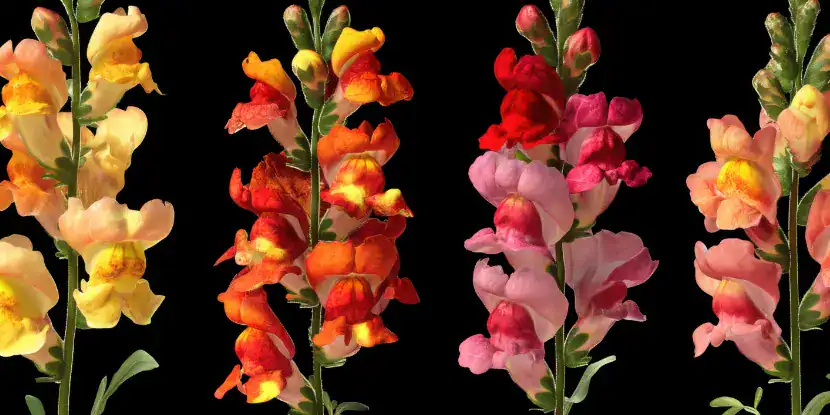
Choose your color! Snapdragons cover the entire palette.
Optimal Growing Conditions
Light
- Snapdragons thrive in full sun but can tolerate partial shade, particularly in Southern California’s hotter areas.
- They need 6–8 hours of daily sunlight for healthy growth.
Temperature
- Snapdragons perform best in cooler weather, when temperatures range between 60°F and 75°F during the day.
- They withstand light frosts, making them an excellent fall-to-spring flowering option.
- Extreme heat can stunt their growth, so plant them during the cooler months.
Soil
- Give them well-drained, nutrient-rich soil with a slightly acidic to neutral pH (6.0–7.0).
- Add compost or organic matter to improve soil quality and drainage.
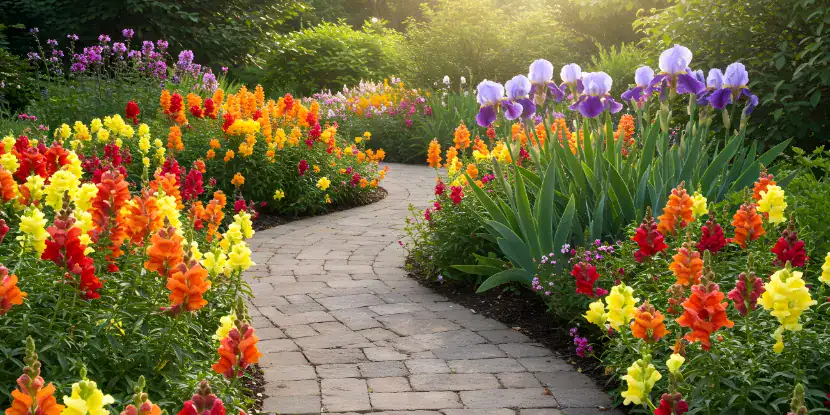
Snapdragons and irises line a garden path.
Planting Snapdragons
Snapdragons can be grown from seeds or cuttings. Pick a sunny spot with well-drained soil prepared with compost or organic matter.
Seeds
- Start snapdragon seeds indoors 6–8 weeks before the last frost.
- Sow them on the surface of moist soil, as they need light to germinate.
- Space each plant 6–12 inches apart, depending on the variety; this allows for proper air circulation.
- Keep the soil moist and expect germination in 10–14 days.
Cuttings
- For quicker results, take 4-inch cuttings from an existing plant.
- Remove the lower leaves and plant the cuttings in moist soil or water until roots form.
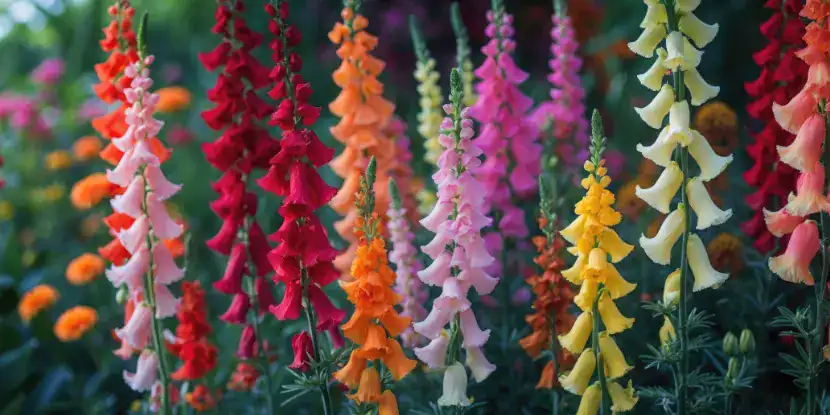
Delicate bell-shaped snapdragon flowers.
Snapdragon Care
Water
- Keep the soil consistently moist, but not soggy.
- Water deeply once or twice a week, allowing the top inch of soil to dry out between watering sessions.
Fertilizer
- Use a balanced fertilizer (10-10-10) every 4–6 weeks to promote healthy growth.
- For an organic option, consider compost tea or fish emulsion.
Pests & Diseases
- Monitor for pests like aphids and spider mites. Use insecticidal soap or neem oil for treatment.
- Prevent fungal diseases like powdery mildew by planting in well-ventilated areas and avoiding overhead watering.
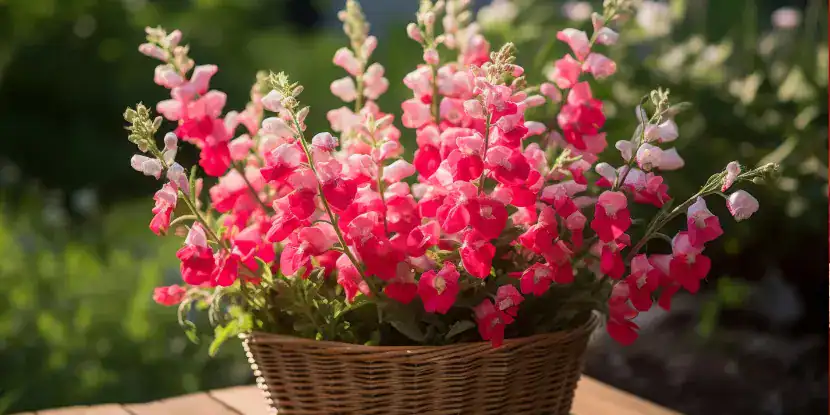
Snapdragons grow equally well in containers or in the garden.
Deadheading
- Deadhead regularly to encourage new blooms and prevent the plant from going to seed.
- Deadheading also prevents the plant from using energy to produce seeds.
- Use clean pruning shears to snip off faded flowers just above a set of healthy leaves.
Cutting Snapdragons for Arrangements
Snapdragons make stunning floral arrangements due to their height, vibrant colors, and unusual blooms.
- Cut early in the morning when the flowers are hydrated.
- Choose spikes with unopened buds. They’ll continue to bloom in the vase.
- Use sharp, clean scissors to avoid damaging the plant.
- Immediately place the cut stems in cool water and add flower food for longer-lasting arrangements.
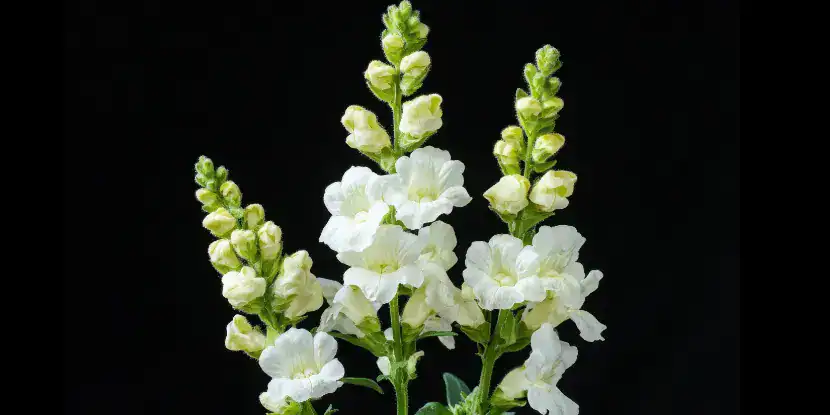
A close-up of cut snapdragons in a simple floral arrangement.
FAQs: Growing & Caring for Snapdragons
Q: How tall do snapdragons grow?
Snapdragons range from 6 inches to 3 feet tall, depending on the variety.
Q: Can snapdragons grow in pots?
Yes, as long as the containers have good drainage and the plants receive enough sunlight.
Q: Are snapdragons perennials?
Snapdragons are usually grown as annuals, but in mild climates like Southern California, they can act as short-lived perennials.
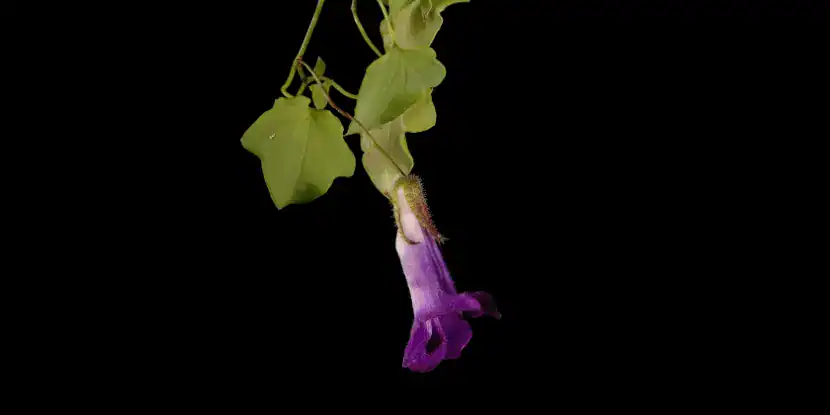
Close-up of a trailing snapdragon blossom.
Q: Can snapdragons survive frost?
They can handle light frosts, allowing for winter gardening in California.
Q: What companion plants pair well with snapdragons?
Companion plants like pansies, violas, and marigolds work well with snapdragons for a colorful, harmonious garden.
Q: How long do snapdragons last in a vase?
With proper care, snapdragons can last up to 10 days in a vase.
Q: Are snapdragons toxic to pets?
Snapdragons are generally non-toxic to pets, which is good news for Beau, who eats everything.

